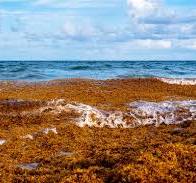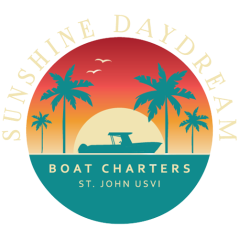Sargassum in the U.S. Virgin Islands: A Growing Environmental Concern
The U.S. Virgin Islands (USVI), a tropical paradise known for its pristine beaches, clear turquoise waters, and vibrant marine life, has been facing a growing environmental challenge: sargassum. This brown seaweed, which drifts across the Atlantic Ocean in vast mats, has become an increasingly common sight along the shores of the Caribbean, including the USVI. While sargassum plays a vital role in marine ecosystems, providing habitat and nourishment for a variety of marine species, its recent proliferation has caused significant environmental, economic, and health-related concerns in the region.
The Nature of Sargassum
Sargassum is a genus of brown macroalgae, commonly known as seaweed, that floats freely on the ocean’s surface. Unlike most seaweeds, sargassum does not need to attach to the ocean floor to thrive. It can form large, dense mats that drift with ocean currents across vast distances. The Sargasso Sea, located in the North Atlantic, is named after this seaweed, which has traditionally been concentrated there. However, in recent years, the distribution of sargassum has expanded dramatically, with large blooms occurring in the Caribbean Sea and Gulf of Mexico.

Sargassum still in the water
Causes of the Sargassum Blooms
The causes of the increasing sargassum blooms are complex and multifaceted. Climate change is a significant factor, with rising sea temperatures creating favorable conditions for the algae to thrive. Warmer waters, along with altered ocean currents and wind patterns, have facilitated the spread of sargassum into new areas, including the USVI. Additionally, nutrient pollution from agricultural runoff, sewage, and industrial waste entering the ocean has provided an abundant supply of nutrients, such as nitrogen and phosphorus, that fuel the growth of sargassum.
The phenomenon known as the Great Atlantic Sargassum Belt, a massive aggregation of sargassum stretching from West Africa to the Caribbean, has become a persistent source of these seaweed invasions. The belt is believed to be fed by nutrient-rich outflows from the Amazon River and upwelling zones off the coast of West Africa, further exacerbating the blooms. The combination of these factors has led to the near-annual arrival of large quantities of sargassum in the Caribbean, including the U.S. Virgin Islands.
Impact on the U.S. Virgin Islands
The arrival of sargassum in the USVI has had profound effects on the local environment, economy, and community well-being. One of the most visible impacts is the accumulation of sargassum along the coastline. When the seaweed washes ashore in large quantities, it forms thick, rotting mats that can cover entire beaches. This not only detracts from the aesthetic appeal of the islands but also poses several environmental challenges.
Environmental Impacts
Sargassum deposits on the shore can smother seagrass beds, coral reefs, and other important coastal habitats. The decomposition of sargassum releases hydrogen sulfide, a gas that can cause a foul odor and irritate the eyes and respiratory systems of humans and animals. The decaying seaweed also depletes oxygen levels in the water, leading to hypoxic conditions that can harm marine life. Fish kills and disruptions to the local marine ecosystem have been reported in areas heavily affected by sargassum.
Furthermore, the vast mats of sargassum at sea can obstruct the movement of marine species, including sea turtles, which can become entangled in the seaweed or find their nesting sites on beaches blocked by sargassum deposits. The impact on the marine food web is also a concern, as the algae can disrupt the feeding patterns of various species.
Economic Impacts
The tourism industry, a cornerstone of the USVI’s economy, has been particularly affected by the sargassum influx. Pristine beaches, a primary draw for tourists, can become unappealing or even inaccessible when covered in rotting seaweed. The unpleasant odor and unsightly appearance of sargassum-laden beaches have led to cancellations of bookings, reduced tourist arrivals, and a decline in visitor satisfaction. Hotels, resorts, and local businesses that rely on beach tourism have faced financial losses, and the cost of cleaning up the sargassum has placed an additional burden on local governments and communities.
The fishing industry, another vital economic sector in the USVI, has also felt the impact. Fishermen have reported difficulties navigating through thick sargassum mats, which can damage boats and fishing gear. The algae can clog nets and traps, reducing catch efficiency and causing frustration among local fishers. The depletion of fish stocks due to hypoxic conditions and changes in the marine ecosystem further threatens the livelihood of those who depend on the ocean for their income.

Sargassum washed up on shore and starting to decompose
Health and Community Impacts
The health implications of sargassum cannot be overlooked. The hydrogen sulfide gas released by decomposing sargassum can cause respiratory problems, headaches, and skin irritations among those exposed to it for extended periods. Communities living near affected beaches may experience a decline in air quality, leading to increased health concerns, particularly for vulnerable populations such as children, the elderly, and those with pre-existing respiratory conditions.
Moreover, the community’s relationship with the ocean and its enjoyment of coastal spaces have been disrupted. Beaches that once served as recreational and social hubs have become less accessible, affecting the quality of life for residents. The need to manage and clean up sargassum has also placed additional stress on local resources and infrastructure.
Management and Mitigation Efforts
Addressing the sargassum issue in the USVI requires a multifaceted approach that involves local, regional, and international collaboration. Efforts to manage and mitigate the impacts of sargassum have included beach clean-up initiatives, public awareness campaigns, and research into sustainable solutions.
Beach Clean-Up and Disposal
Local governments and community organizations have organized regular beach clean-ups to remove sargassum deposits. However, these efforts are labor-intensive and costly, often requiring heavy machinery and large teams of workers. The disposal of collected sargassum also presents challenges, as the seaweed cannot simply be dumped in landfills due to its volume and potential environmental hazards. Some innovative approaches have explored using sargassum as a source of biofuel, fertilizer, or animal feed, though these solutions are still in the experimental stages and face logistical hurdles.
Monitoring and Forecasting
Improved monitoring and forecasting of sargassum blooms have become essential tools in managing the issue. Satellite imagery and oceanographic models are being used to predict the movement of sargassum mats, allowing authorities to prepare for and respond to incoming seaweed more effectively. Early warning systems can help communities and businesses take preemptive action, such as deploying barriers to prevent sargassum from reaching shore or adjusting tourism operations to minimize disruptions.
Long-Term Solutions
In the long term, addressing the root causes of sargassum blooms, such as nutrient pollution and climate change, will be crucial. Regional cooperation among Caribbean nations, as well as international efforts to reduce greenhouse gas emissions and improve ocean health, will play a significant role in mitigating the future impact of sargassum on the USVI and other affected areas.
Conclusion
The sargassum phenomenon in the U.S. Virgin Islands is a complex and evolving challenge that highlights the interconnectedness of environmental, economic, and social systems. While the seaweed is a natural part of the ocean ecosystem, its recent proliferation due to human-induced factors has created significant disruptions in the region. As the USVI grapples with the consequences of sargassum, it is imperative to continue exploring adaptive and sustainable strategies that protect the islands’ natural beauty, support local communities, and preserve the health of the marine environment.
